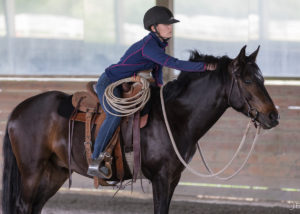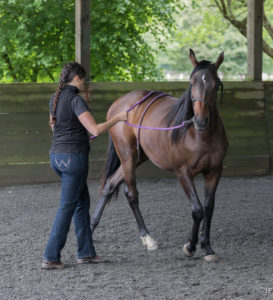SAFE’s Horsemanship Program is managed by Operations Director Terry Phelps, and is the most important part of SAFE’s Training Program. Many SAFE horses are started or re-started under saddle by Joel Conner, but the horses are only with Joel for a short time, 30 to 60 days on average. The most crucial parts of the training process come both BEFORE the horses go to Joel and AFTER they graduate and return home to SAFE.
They say that every single interaction you have with a horse is a training moment for the horse. This is why the work that is done with the horses before they go to Joel is so vital. New horses often come to SAFE with either no training or incorrect training. In both cases, there are weeks or even months of work that goes into preparing a horse to be started/re-started under saddle. SAFE could pay Joel Conner to handle this phase of training too…but we are extremely fortunate to have a small group of people on our team who have trained extensively with Joel and learned the proper techniques for establishing good foundations in a horse. These are the core SAFE volunteer riders.
This is a small group, handpicked by Terry and invited to join the team. Each rider makes a commitment to work with their assigned horse (or horses) several days per week. They work closely with Terry to report their progress, discuss successes and setbacks, and plan each step of the training process. The horses are periodically evaluated by Joel and once he and Terry determine they are ready, they are sent to Ellensburg to begin their under-saddle work.
Even while the horses are with Joel, Terry and the volunteer riders remain involved with the horses’ progress, and often make the trip over to Ellensburg to watch Joel work with “their” horse and possibly ride him or her under Joel’s direction.
When the horses return from Ellensburg, the next phase of their development begins. Using the methods and skills they have learned from Joel, as well as insights into the specific horse they are working with, they will work with their horse several days each week to continue its training.
A typical session begins with grooming and saddling, followed by ground work, and then riding. The important thing is consistency – proving the horse with an educational experience that he or she understands and is familiar with. This is why we insist that everyone in the Volunteer Rider program be well versed in the type of horsemanship that Joel Conner practices. We insist that they constantly increase their knowledge with further education, and improve their skills with dedicated practice. This is not a commitment that anyone makes lightly. It is a lot of work. It’s also completely invaluable to the success of SAFE’s adoption program, and we are so lucky that these individuals are willing to lend us their time, energy, and talents.
During this stage of the training process, only the assigned volunteer rider will be working with the horse. Again, this is for the sake of consistency. The goal is to get the horse to a point where he or she can be safely ridden by a potential adopter. Some horses may attract the interest of adopters who are highly skilled riders who agree to continue their training after they leave SAFE. Other horses will remain with SAFE until they become more “amateur friendly.” When a horse reaches that point, he or she will start being ridden by a more junior volunteer rider, who is closer in skill level and style to a typical adopter.
Very occasionally, SAFE takes in a horse who does not require the extensive training described here. These are horses who come to us already well trained, and it’s a rarity because, let’s face it, well-trained horses rarely need to be rescued!! But when we have a horse of this description in the barn, we will occasionally let other volunteer riders work with the horse. A commitment is still required, but it’s not necessarily as large a commitment as the ones made for the more challenging horses.
A few more things I’d like to point out about the volunteer riders, particularly the senior/core group that is currently working with Terry:
• You may not realize how hard these gals are working. Sometimes they even make it look easy, but it isn’t. We have one volunteer rider who currently comes 5–6 times per week to ride 3 different horses. This is a huge commitment to SAFE, and something she does because she cares so deeply about our horses.
• The core volunteer riders are sharing years of practice, learning, and training with us, at no cost. SAFE pays $900 per month for training and board for each horse at Joel Conner’s. The money they are personally saving us really adds up. Not to mention, our horses are being adopted faster and more successfully than ever before.
• These riders are taking a personal risk by getting on these horses. This is true of anyone who ever gets on a horse, but it still should be acknowledged that no matter how careful we are, they are exposing themselves to potential injury or death. Even if the worst does not happen, they risk muscle pulls, back problems, scrapes and bruises, and some serious bad hair days.
• Just because you have never seen one of these gals cleaning a stall, doesn’t mean they haven’t. The aforementioned rider who comes here 5–6 days per week held down a PM chore shift at the Woodinville barn for years. Frankly SAFE needs these people doing what they do best. It doesn’t mean they’re better than the rest; it just means we’ve asked them to share different skills.
So here’s the more frequently asked frequently asked question of all: Can I ride a SAFE horse?
The short answer is probably not. We’re not operating a riding stable and we don’t have the horses, staff, or liability coverage to offer riding to everyone. If you yearn to learn to ride, why not do what I did: go take riding lessons from a trained professional! In this area there are countless options for people who want to ride but don’t own a horse. It is the absolute best way to get started, or continue your education.
That said, there are opportunities at SAFE to work with some of the horses, and these opportunities are open to anyone who is willing and able to put in the time and make a commitment. We need volunteers who can work with our companion horses.
Our companion horses, those who can’t be ridden, don’t get as much attention as the riding horses and that needs to change! Here are some things that companions can enjoy:
· Hand grazing
· Hanging out listening to you talk
· Grooming
· Light ground work
· Trail walking
· Trick training
· Halter and Showmanship training
If this sounds fun to you, here’s how to get started:
No matter your skill level, we’d like to start by provide you with some basic skills before we match you up with a horse. Terry is developing a series of Foundations Workshops to teach horse handling and groundwork. These will be held Thursday nights from 4:30–6:00pm at the barn. Right now, the session are in “tester mode” while we work out the bumps but pretty soon, Terry will be opening them up to more people. If you’re interested, send Terry an email at terry@safehorses.org to get on the waiting list.




